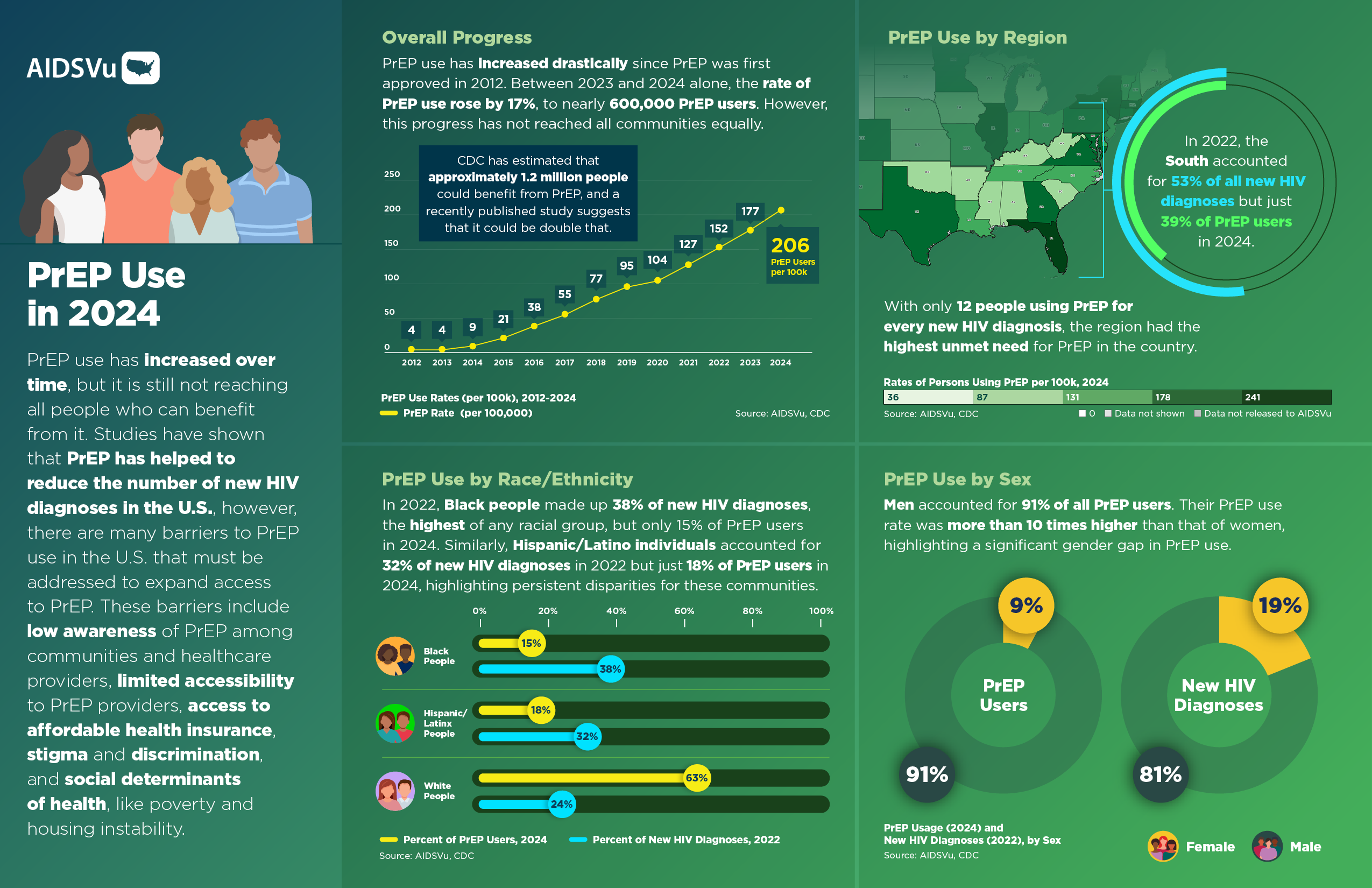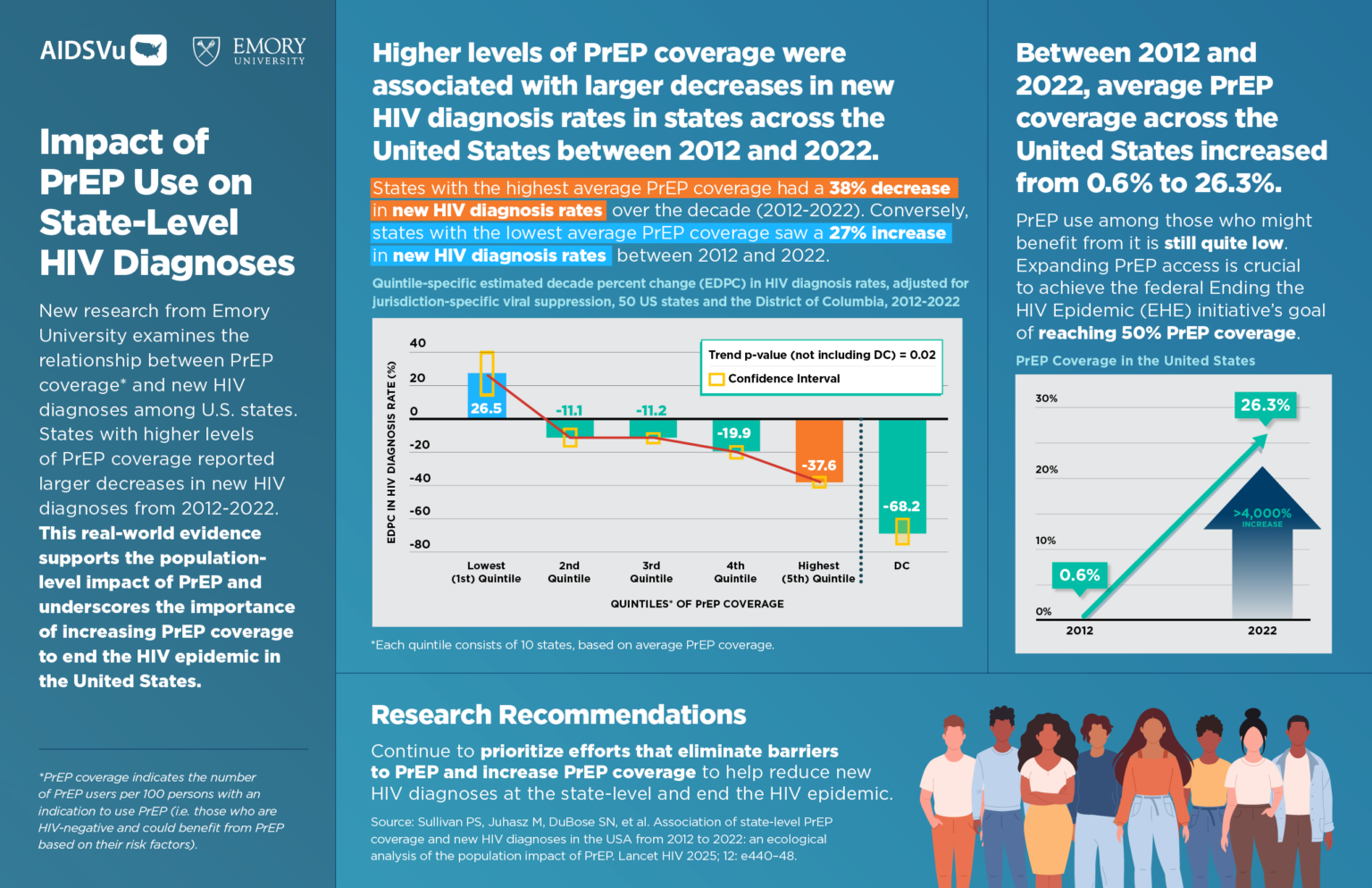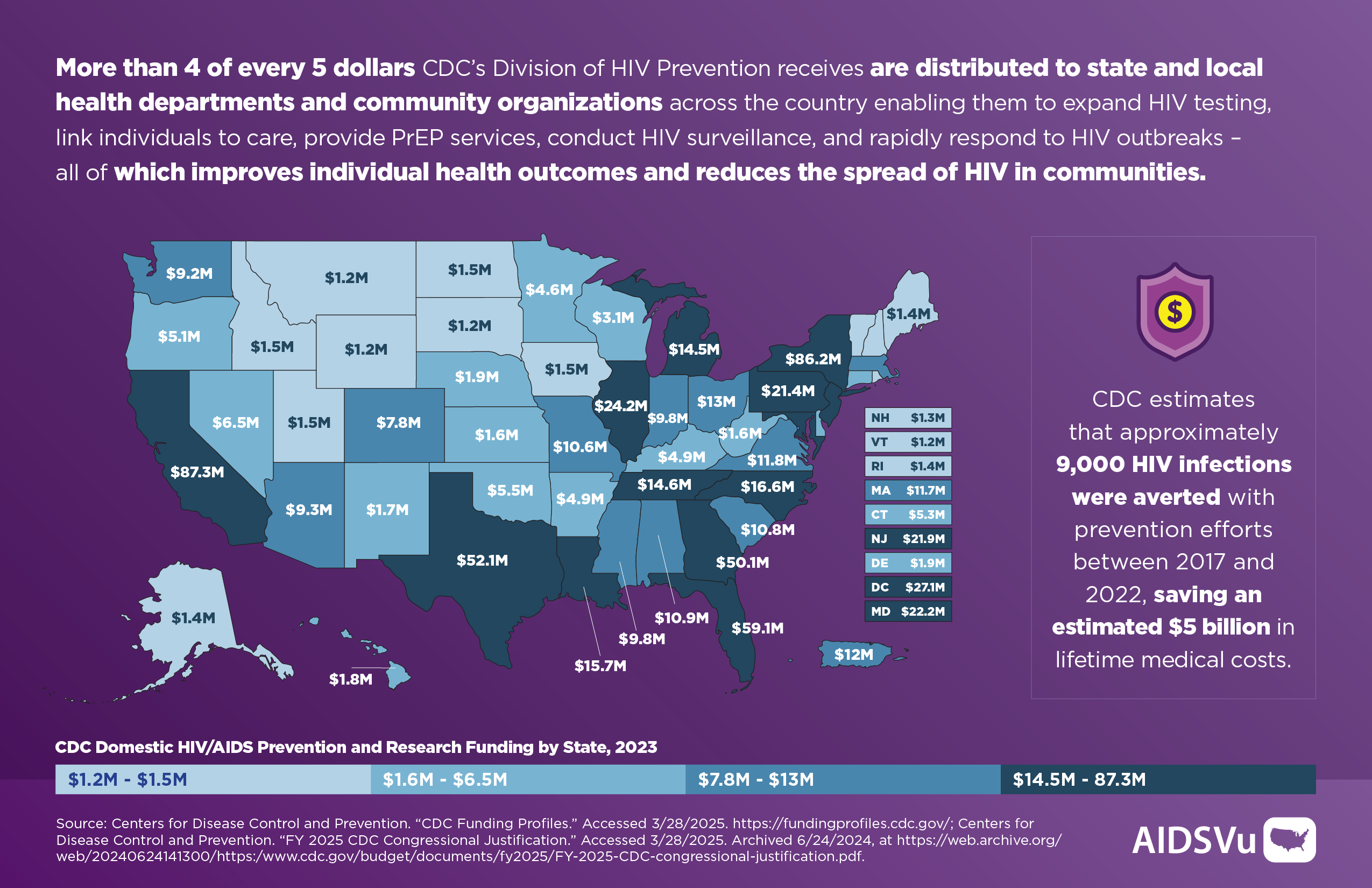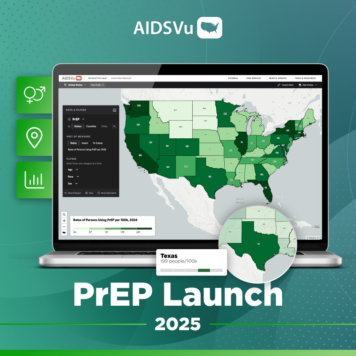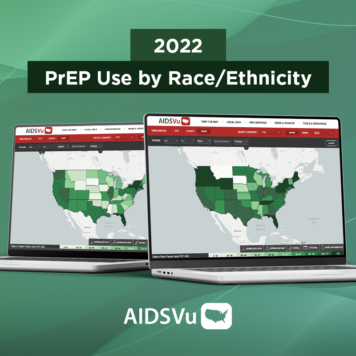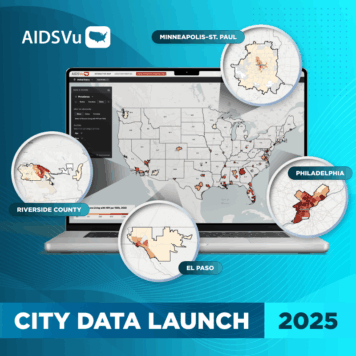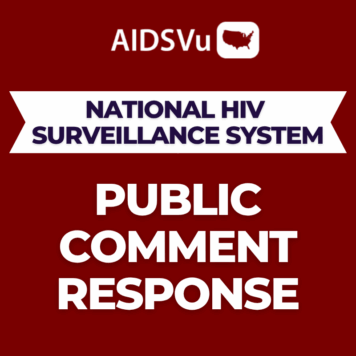Nearly 600,000 people are using PrEP in the U.S., but many more could benefit from it
Atlanta, GA, June 26, 2024 — Today, AIDSVu announced the release of its latest national Pre-Exposure Prophylaxis (PrEP) use data and maps, capturing PrEP use for HIV prevention through 2024. Since 2012, the number of PrEP users in the U.S. has grown significantly. Between 2023 and 2024, PrEP use increased by 17% to 591,475 people—mirroring the rise seen from 2022 to 2023. This new data offers critical insight into the populations and areas of the country that are accessing PrEP, where gaps remain, and how trends have evolved over time. The data reveals both progress and persistent disparities, especially among Black, Hispanic/Latino, young, female, and Southern populations.
PrEP, or pre-exposure prophylaxis, significantly reduces an individual’s chances of getting HIV. When taken as prescribed, PrEP is highly effective for preventing HIV. The Centers for Disease Control and Prevention (CDC) has estimated that approximately 1.2 million people could benefit from comprehensive HIV prevention strategies, including PrEP, although a recently published study suggests that it could be double that. However, individuals and communities continue to face barriers to PrEP, including low awareness of PrEP, limited accessibility to PrEP providers, access to affordable health insurance, stigma and discrimination, and social determinants of health, like poverty and housing instability.
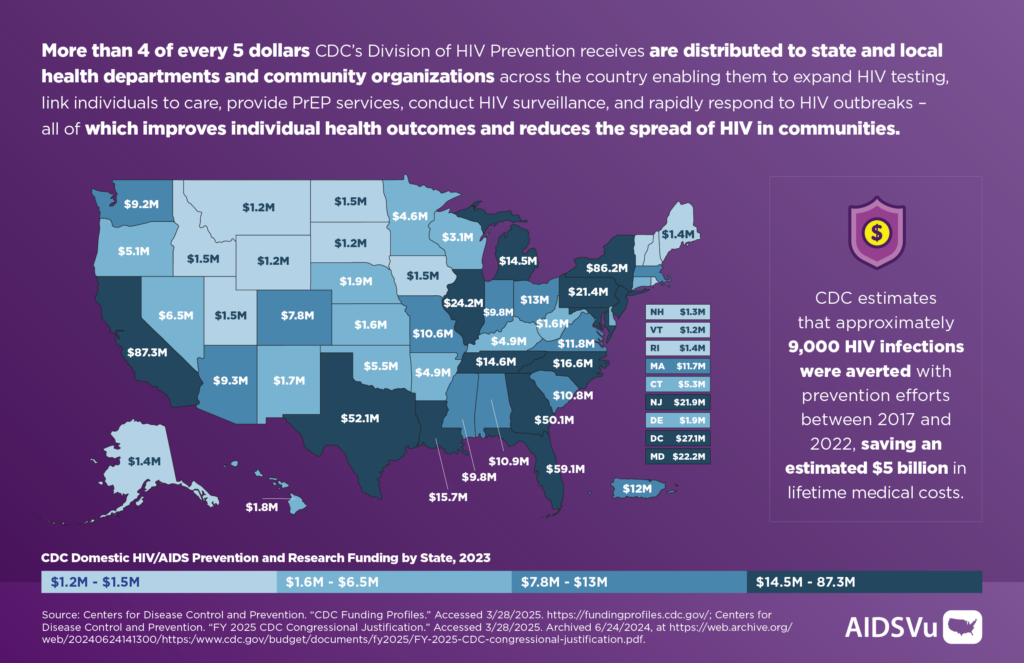 Funding Cuts Threaten Continued Progress
Funding Cuts Threaten Continued Progress
Despite clear evidence that increased PrEP use is associated with reduced new HIV diagnoses and reduced long-term health costs, critical federal HIV prevention funds are under threat. Federal funding helps support access to PrEP and other essential HIV prevention services in every state across the U.S., including community education and outreach, HIV testing, and linkage to care.
Cuts to CDC’s Division of HIV Prevention, potential cuts to the Ryan White HIV/AIDS Program, and other public health resources jeopardize access to PrEP, particularly in regions and populations with the highest unmet need, including the South.
Policies impacting Medicaid and/or the Affordable Care Act, or court decisions like Braidwood v. Kennedy threaten to undermine healthcare coverage and funding for HIV prevention and care. Disparities could worsen without sustained investment in prevention, education, and care access—especially for Black, Hispanic/Latino, young, female and Southern populations.
AIDSVu’s 2024 data release serves as both a resource and a call to attention; in order to end the HIV epidemic in the U.S., federal HIV funding must be protected, decision-making must be data-driven, and PrEP must reach those who need it most.
“We know PrEP works—both at the individual and population level,” said Dr. Patrick Sullivan, Professor of Epidemiology at Emory University and Principal Scientist for AIDSVu. “Our data show that as PrEP use increases, new HIV infections decline. But persistent barriers—like limited healthcare access, stigma, lack of insurance coverage, and low awareness—continue to stand in the way for too many.”
“Gains achieved over the past decade are now at risk,” Sullivan added. “Federal funding for HIV prevention and PrEP services is under threat, and this progress could be rolled back. To sustain impact, we must invest in local outreach, provider training, and expanded PrEP access in primary care and STI clinics. State policies, including PrEP Drug Assistance Programs and Medicaid protections, are critical. So is ensuring insurance coverage for PrEP and related services without cost or restrictions. Continued federal and state investment will prevent new infections, save lives, and reduce long-term healthcare costs.”
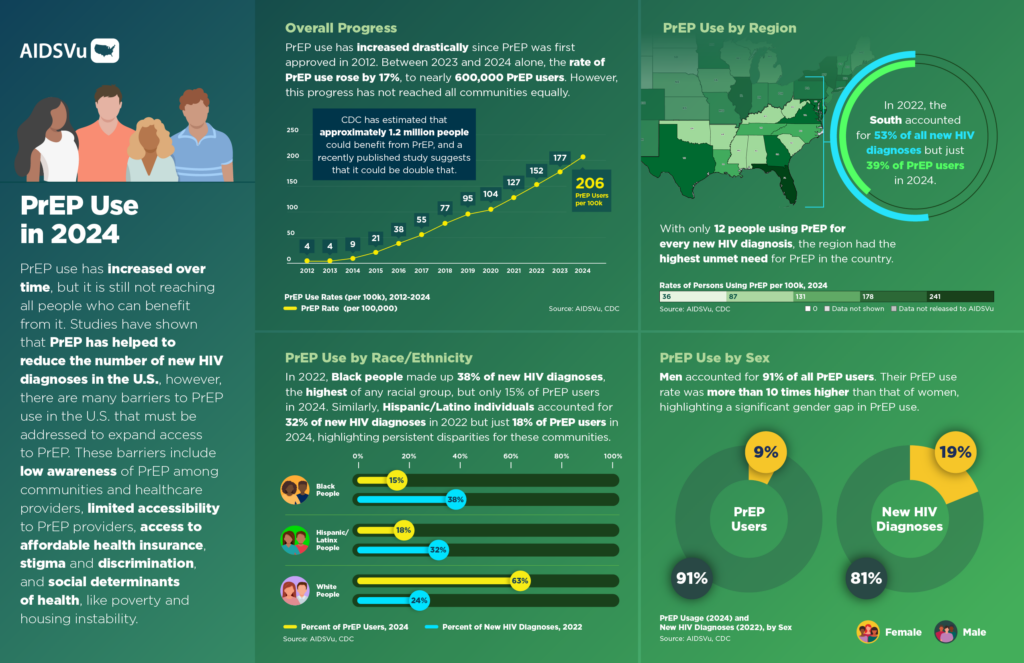 2024 PrEP Use Data Highlights
2024 PrEP Use Data Highlights
National Trends in PrEP Use
PrEP Uptake Continues to Rise
- Since 2012, the number of PrEP users in the U.S. has grown significantly. Between 2023 and 2024, PrEP use increased by 17% to 591,475 people—mirroring the rise seen from 2022 to 2023.
- The national PrEP-to-Need Ratio (PnR)* improved to 15.6 in 2024, up from 13.3 in 2023, signaling progress—but persistent disparities remain.
PrEP Use by Sex
PrEP Use Remains Skewed Toward Men
- In 2024, 91% of PrEP users were male. Men accessed PrEP at a rate 10 times higher than women.
- Despite representing nearly 19% of new HIV diagnoses in 2022, women continue to be underrepresented among PrEP users, representing only 9% of PrEP users in 2024.
PrEP Use by Age
Teens and Young Adults Would Benefit from Increased PrEP Use
- Adults ages 25–34 made up 37% of all PrEP users in 2024, and 65% of users were between 25–44 years old.
- Young people aged 13-24 represented 18% of new HIV diagnoses in 2023 and 11% of PrEP users; adults ages 25-34 represented 37% of new HIV diagnoses and 37% of PrEP users during that same period.
- PnR was highest among those aged 35–44 and 65+, with both age groups having 19 PrEP users for every one new diagnosis in each of those age groups. PnR was lowest among 13–24-year-olds, with only 10 PrEP users for every one new diagnosis in that age group, highlighting gaps in access for the youngest population.
PrEP Use by Race/Ethnicity
Racial and Ethnic Disparities Persist
- PrEP use continues to lag among Black and Hispanic/Latino communities, despite their disproportionate burden of new HIV diagnoses:
- Black individuals accounted for 38% of new diagnoses in 2022, but just 15% of PrEP users in 2024.
- Hispanic/Latino individuals made up 32% of new diagnoses in 2022 and 18% of PrEP users in 2024.
- White individuals represented 24% of new diagnoses in 2022, yet 63% of PrEP users in 2024.
PrEP Use by Region
The South Faces the Greatest Unmet Need
- The South accounted for 53% of new HIV diagnoses in 2022 but only 39% of PrEP users in 2024 and had the lowest regional PnR at 12. The Northeast had a PnR of 25, the Midwest had a PnR of 18, and the West had a PnR of 19.
- Across all regions, the PrEP-to-Need Ratio was highest among White individuals and lowest among Black individuals.
*Note: The PrEP-to-Need Ratio (PnR)—the ratio of the number of PrEP users to the number of people newly diagnosed with HIV—serves as a measurement for whether PrEP use appropriately reflects the need for HIV prevention in a geographic region or demographic subgroup. A lower PnR indicates more unmet need for PrEP. 2024 and 2023 PnR were calculated using 2022 new HIV diagnoses as the denominator.
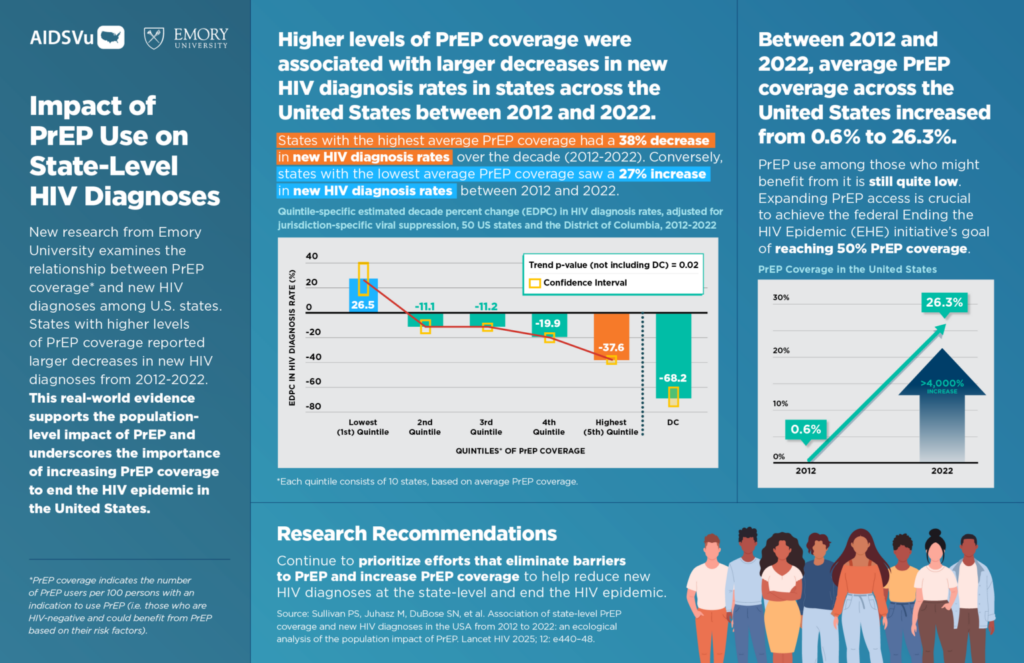 Groundbreaking PrEP Analyses from the AIDSVu Team
Groundbreaking PrEP Analyses from the AIDSVu Team
A study recently published in The Lancet HIV reveals that U.S. states with the highest pre-exposure prophylaxis (PrEP) coverage experienced a 38% drop in new HIV diagnoses from 2012 to 2022, while states with the lowest coverage saw a 27% increase. This is the first comprehensive, decade-long analysis to show the population-level impact of PrEP, a medication proven to prevent HIV infection. The findings underscore PrEP’s critical role in the federal Ending the HIV Epidemic initiative, demonstrating its effectiveness not only for individuals but also for reducing new infections and healthcare costs across entire communities.
PrEPVu.org Additional Resources
Through data incubation, analysis and visualization, PrEPVu offers an understanding of PrEP use across the country and the people and communities with the greatest unmet need for PrEP.
- Interactive maps of PrEP use and PrEP-to-Need Ratios by age, sex, race/ethnicity, and geography.
- Data dashboards and policy tools tailored for public health officials, researchers, and advocates.
- A monthly newsletter, PrEPVu Monthly, offering insights, expert commentary, and community spotlights.
Additional PrEP resources on AIDSVu include a Deeper Look: PrEP page providing further insights on AIDSVu’s PrEP use and PnR data, downloadable infographics and data sets, national, regional, state, and county profiles, and blogs by HIV experts.
AIDSVu also features a PrEP Locator, a national directory of public and private practice providers of PrEP across the U.S. AIDSVu users can find local PrEP providers near them with this tool or overlay service locations on top of AIDSVu’s PrEP use maps.
About AIDSVu
AIDSVu is presented by Emory University’s Rollins School of Public Health in partnership with Gilead Sciences, Inc. and the Center for AIDS Research at Emory University (CFAR). Now in its fifteenth year, AIDSVu continues to advance its mission to make HIV data widely available, easily accessible, and locally relevant to inform public health decision-making and action. The site aims to provide researchers, policymakers, and community members with a more comprehensive understanding of the HIV epidemic at the local-, state-, and national- level.
About the Data
The release of the PrEP use data on AIDSVu was made possible through a data-sharing agreement, in which data were obtained from IQVIA with the support of Gilead Sciences, Inc., and compiled by researchers at the Rollins School of Public Health at Emory University.
IQVIA provides Emory a limited dataset of aggregated and anonymized pre-exposure prophylaxis (PrEP) data, along with age, sex, and race/ethnicity classifications. The IQVIA database contains anonymized individual-level prescription records collected electronically from US retail pharmacies, traditional pharmacies, specialty mail-order pharmacies, long-term care (LTC) facilities, and “other” pharmacies (e.g., in-hospital pharmacies, HMO pharmacies). The IQVIA database uses national estimates of prescription fills to estimate PrEP prescriptions for the small percentage of US prescriptions that are not tracked directly by IQVIA. The prescriptions database includes age and sex and was linked to a claims database to obtain diagnoses codes. Race/ethnicity was provided through a consumer database of self-reported information. Race/ethnicity data were available for about a third of PrEP users, and data summarized by race/ethnicity are based on that subset of users.
An algorithm was used to differentiate the HIV treatment and HIV PrEP indications using prescription and diagnoses data for individuals taking FTC/TDF, FTC/TAF after its approval in 2019, or cabotegravir after its approval in 2021. For AIDSVu, the analyses determined total PrEP usage with FTC/TDF, FTC/TAF, and cabotegravir and not individually for each product. IQVIA excluded prescriptions for TDF/FTC, TAF/FTC, and cabotegravir that were made for other known indications, such as, post-exposure prophylaxis (PEP), chronic hepatitis B management, and treatment for HIV and other opportunistic infections. An individual with diagnosis or treatment codes for HIV, chronic Hepatis B or codes for PEP prior to the exposure era of FTC/TDF, FTC/TAF, or cabotegravir would be considered not to be taking PrEP. Additional details can be found in the Technical Notes.
IQVIA shared aggregate datasets at the state- and county-level with Emory researchers. To account for underestimations of PrEP use due to misclassified prescriptions, the county-level PrEP users’ data were upweighted by using state-specific percentages of unclassified prescriptions (prescriptions that have an unknown indication). The method was adopted from Sullivan et al.’s published article in Annals of Epidemiology titled “Methods for county-level estimation of pre-exposure prophylaxis coverage and application to the U.S. ending the HIV epidemic jurisdictions.” The unrounded number of weighted PrEP users per county were then summed to obtain state-, regional-, and national-level estimates. Finally, Emory applied data suppression rules and developed the publicly available maps and data sets for AIDSVu. AIDSVu provides downloadable PrEP maps and datasets at the county-and state-level and PrEP datasets at the regional and national-level for researchers and health departments to utilize in their own analyses.
PrEP data are displayed as number of PrEP users and rates. Rates of PrEP use were calculated per 100,000 population to permit data standardization and comparison. The PnR data compare the ratio of the number of PrEP users from 2012-2024 to the number of people newly diagnosed with HIV in each corresponding year. The numerator is number of PrEP users, by year, and the denominator is new HIV diagnoses cases, by year. Since 2022 new diagnoses is the latest year available on AIDSVu, it is used to calculate 2023 and 2024 PnR. As newer data becomes available, the 2023 and 2024 PnR will be updated with future data launches.
The statements, findings, conclusions, views, and opinions contained and expressed on the AIDSVu website are based in part on data obtained under license from the following information service(s): LAAD Longitudinal Access and Adjudication Dataset HIV data, January 2012 – December 2024), IQVIA Inc. All Rights Reserved. The statements, findings, conclusions, views, and opinions contained and expressed herein are not necessarily those of IQVIA Inc. or any of its affiliated or subsidiary entities. Any analysis is independently arrived at by Emory University, on the basis of the data and other information.

